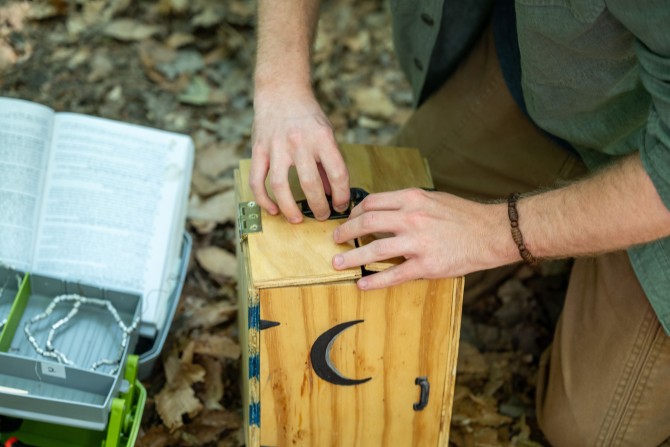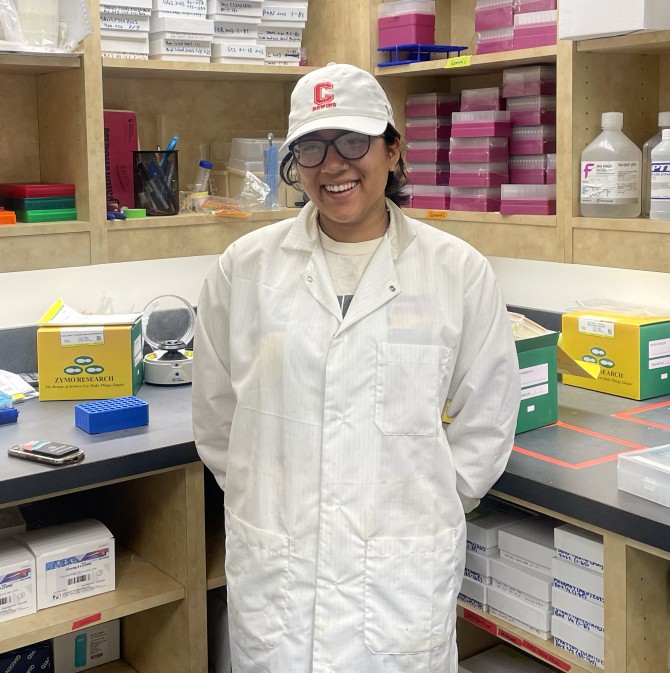
Student Tasos Stefanou (left) works with Lab of Ornithology postdoc Gemma Clucas to recover a woodpecker captured in a mist net.
News directly from Cornell's colleges and centers
Birds, beetles, and woodland research
By Ruth Charles-Pedro
Under the watchful eye of Kim Savides, a veteran bird handler at the Cornell Lab of Ornithology, undergraduate researcher Tasos Stefanou ‘26 carefully untangles a red-bellied woodpecker from a net hanging between trees in Sapsucker Woods.
Stefanou gently places the bird in a wooden box affectionately known as the “outhouse.” They wait, hoping for a woodpecker fecal sample. After 10 minutes, the red-bellied woodpecker produces a dropping with DNA that may hold clues about an invasive pest that’s killing forests across the continent.
Stefanou is one of 12 students who have immersed in research with Lab of Ornithology postdoctoral fellows Andrew Stillman and Gemma Clucas. Their goal is to understand the role that woodpeckers play in the outbreak of emerald ash borer beetles, invasive insects that are responsible for the deaths of thousands of ash trees in Ithaca and the eastern United States.
Are woodpeckers eating emerald ash borers? How often? Does the rate of consumption change throughout the season? These are some of the questions that Stillman and Clucas hope students will help answer. By offering mentorship, they hope to educate and inspire the next generation of scientists.
“I know that I benefited a lot as an undergrad, being able to jump on different projects and have a taste of what it means to do research,” says Clucas. “It’s nice to be able to create and give those opportunities back to students.”
The project began in 2022 after Stillman noticed scores of dead ash trees in the Sapsucker Woods Sanctuary and broader Ithaca community. He called the crisis a “biological invasion in our backyard.”
Originating in East Asia, the metallic green beetle arrived in Michigan in the early 2000s. It has since spread to 36 states, Washington, D.C., and 5 Canadian provinces. Trees infested with emerald ash borers have a 95% mortality rate, which jumps to 99% in severe cases. For forests that depend on ash tree canopies for shade, this loss has serious implications for the ecosystem’s health.
During the project’s first year, the research team partnered with the Ithaca Learning Web to bring high schoolers into the woods to help collect data on woodpecker diets and behaviors. The nonprofit provides career development and educational programs to local youth.
The students learned to differentiate between bird species in the study: red-bellied woodpeckers, downy woodpeckers, hairy woodpeckers, and white-breasted nuthatches. They also learned to work with the research equipment and collect high quality data for scientific experiments. Stillman believes that exposing students to field research may ignite an appreciation for nature and a will to protect it—even if they don’t decide to pursue a career in biology.
“We’ve got a problem if the only people who spark a passion and an appreciation of nature are scientists,” says Stillman. “I want our future business leaders and professionals from all walks of life to also have these spark moments.”
Alongside Stefanou, Mei Rao ‘25, has taken her research from the woods into the laboratory. She’s now working to extract DNA from more than 100 fecal samples collected since the project’s inception. For Rao, lab work is another opportunity to grow as a researcher and advance in her career.
“Lab skills in general are always good to have and I think that genetics is one of those fields that’s widely applicable,” explains Rao. “Like, yes, I’m working with birds now. But it’s the same DNA whether I extract it from a bird, a bat, a lion, or a giraffe.”
Rao will move the samples through rounds of filtration to extract the birds’ DNA. Using genomic sequencing techniques, the researchers hope to uncover the role that woodpeckers play in the emerald ash borer invasion—information that can yield new insights about the birds, the pests, and the trees.
As the study enters its fourth year, Stillman and Clucas remain dedicated to providing more opportunities to see their students grow. And their efforts are appreciated.
“I’m surrounded by such cool people,” exclaims Rao. “If I didn’t work here, I don’t know what I would do.”
Ruth Charles-Pedro ’25 is a student science writer at the Cornell Lab of Ornithology.
Media Contact
Get Cornell news delivered right to your inbox.
Subscribe


